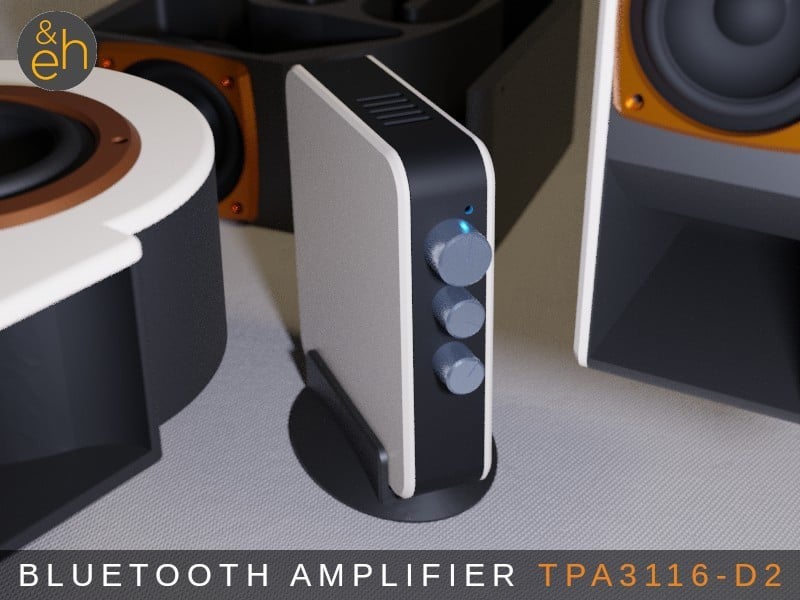
Bluetooth Stereo Amplifier 2x50W TPA3116D2
thingiverse
<b>UPDATE 31Jan2021: The new 2.1 Bluetooth amplifier enclosure is online: https://www.thingiverse.com/thing:4743037</b> <b><font color="#850000">Bluetooth Amplifier Enclosure</b> So here is the enclosure for what is currently my favorite 2x50W TPA3116D2 Bluetooth amplifier board. I wanted it to be upright so it takes up less space (and looks a little different from all those commercial designs out there). Originally designed to complement my printed back horn speakers it finally ended up connected to my JVC Zero 6 speakers and replacing my Marantz receiver (which, however, badly needs new caps and volume controls, anyway - yes, I know, that hurts...). So ended up with two of these little boards (and have already ordered the 2.1 amp from the same brand). <b>First of all, here is what you will need for this project:</b> - The actual <a href="https://s.click.aliexpress.com/e/_9g1Oar">amplifier board: ZK-502T Bluetooth 5.0 2x50W Amplifier Board</a>. The reason I chose this one is that this board has bass and treble controls, aux in, BT 5, virtually no noise, sounds great and even comes with a very basic top/bottom plate (which I am not using), connector, and shiny knobs (also not used in this project, but you can). - Plus a <a href="https://s.click.aliexpress.com/e/_9ikpVZ">12-24V switching power supply</a>. The TPA3116 operates on a wide range of voltage. However, I would definitely recommend a 24V/3A+ (72W) power supply to get the full output (but have also tried with a 12V supply and it sounds surprisingly good, if you have one lying around). <b>Some background</b>. TPA3116D2 is a Texas Instruments chip that has been around for a number of years and has turned into one of the most popular chips in compact amplifier boards. It is extremely power efficient and hence only requires small heatsinks (if any). These boards are also very popular among manufacturers of budget amps (the majority of those 50-100$ amps on the market are TPA3116 and some of these are really good). However, I currently own 6 different boards based on this chip and it seems sound quality (and particularly noise) very much depend on board design. This board is definitely my favorite, good sound, no noise... (just got the 2.1 board from the same manufacturer but didn’t get to try it yet - more in the future). <b>Even a little more more background (for those interested).</b> TPA3116D is a Class-D amplifier. They are particularly energy efficient, cheap and can produce excellent sound quality (although sometimes characterized as somewhat more sterile than Class AB amps). Frequently (falsely) translated as “digital” amplifier, a Class-D amp is actually a switching amp, i.e. an electronic amplifier in which the amplifying devices operate as electronic switches. The principle is actually pretty simple. A comparator compares a high frequency triangular wave with an analog audio input. This generates a PWM (i.e. a series of pulses of which the duty cycle is directly proportional to the input audio signal). The comparator then drives a MOS gate driver which in turn drives a pair of high-power switches and produces an amplified vesion of the original PWM signal. A simple low pass filter removes the high-frequency switching components of the PWM signal and produces an amplified version of the original input signal, which can be fed into an ordinary speaker. <b>Printing and assemblage.</b> Printing should be very straightforward. No supports or bed adhesion needed. I print everything in 0.2-0.28 mm resolution and with 30% infill (lines). <b>Filament.</b> I use <a href="https://s.click.aliexpress.com/e/_Adj4eL">Sunlu Carbon Fiber PLA for the main body</a> and stand (not so much because it needs the additional strength, mainly because it looks really good), the knobs in <a href="https://s.click.aliexpress.com/e/_AWaZ6T">Silk Silver PLA</a> (or gold/bronze, if you like them a little flashier), and the side panels in standard warm white PLA. <b>Print</b> one each of 1.) the main body 2.) the stand 3.) each of the panels 4.) the larger volume control knob and finally 5.) two of the smaller bass/treble control knobs (you could of course use the shiny knobs that come with the amp instead). Slide the board into the enclosure and fix with the 3 nuts of the volume controls. You can use the two small screws (they come with the board) to further secure the board (I have added screw holes to the enclosure) - but it works well without. Glue the bottom/right panel to the main body (I have added holes on the body and pegs on the panel, so it is really easy to mount, even without glue). Connect the speakers and to the terminals and the 12-24V power to the corresponding connector, mount (no need for glue, you want this to be removable) the top/left side panel and you are ready to go. <h4><b>HOPE YOU LIKE IT AND IF YOU LIKE IT PLEASE LIKE IT!</b></h4> <h4>Enjoy.</h4>
With this file you will be able to print Bluetooth Stereo Amplifier 2x50W TPA3116D2 with your 3D printer. Click on the button and save the file on your computer to work, edit or customize your design. You can also find more 3D designs for printers on Bluetooth Stereo Amplifier 2x50W TPA3116D2.
